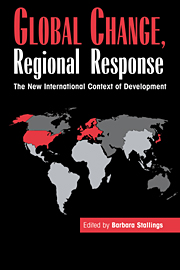Book contents
- Frontmatter
- Contents
- List of tables and figures
- List of contributors
- Acknowledgments
- Abbreviations
- 1 Introduction: global change, regional response
- Part I Global changes
- Part II Regional responses
- 7 The East Asian NICs: a state-led path to the developed world
- 8 Southeast Asia: success through international openness
- 9 Latin America: toward a new reliance on the market
- 10 Sub-Saharan Africa: underdevelopment's last stand
- Part III Conclusions
- Index
9 - Latin America: toward a new reliance on the market
Published online by Cambridge University Press: 05 June 2012
- Frontmatter
- Contents
- List of tables and figures
- List of contributors
- Acknowledgments
- Abbreviations
- 1 Introduction: global change, regional response
- Part I Global changes
- Part II Regional responses
- 7 The East Asian NICs: a state-led path to the developed world
- 8 Southeast Asia: success through international openness
- 9 Latin America: toward a new reliance on the market
- 10 Sub-Saharan Africa: underdevelopment's last stand
- Part III Conclusions
- Index
Summary
Dramatic international changes are forcing third world countries to adapt their agendas and institutions to become part of a new global political economy. In the case of Latin America, massive shifts in international financial flows, the muting of East–West conflict and renewal of U.S. hegemony, the new primacy of markets, and the return to competitive political systems have been the most significant international changes. Accommodation to these changes is producing multiple tensions and conflicts, and it is not yet clear whether the adjustment will produce competitive economies.
During the post–World War II period, Latin American countries' inward-oriented development strategies – the import-substitution industrialization model – determined their main domestic policies and foreign relations. Now the region is facing new systemic conditions, following a decade of severe economic weakness during the 1980s. Looking back at the “lost decade” and comparing it with the success of the Asian economies, most Latin American leaders have concluded that they have no alternative but to accommodate their domestic policies to the new international context. Their initial success in doing so can be seen in recent economic data: inflation is under control in most countries; financial resource flows and investments have increased, despite the turbulence following Mexico's peso devaluation; and growth is beginning to resume. Nonetheless, Latin America lags behind its East Asian rivals in terms of growth and technological progress.
- Type
- Chapter
- Information
- Global Change, Regional ResponseThe New International Context of Development, pp. 272 - 308Publisher: Cambridge University PressPrint publication year: 1995
- 1
- Cited by



